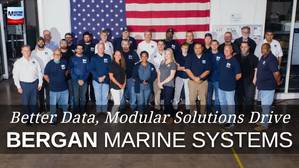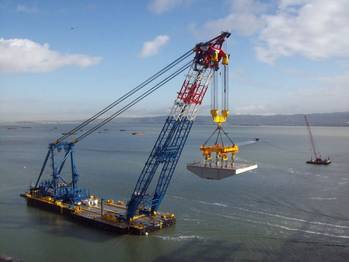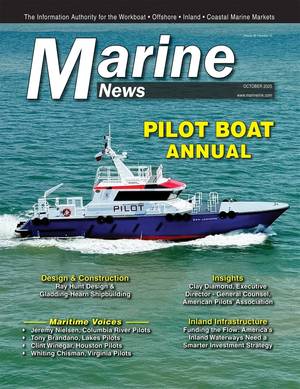Japan
Japanese shipbuilders and equipment suppliers espouse the values of technological innovation and international cooperations to maintain their position at the forefront of commercial shipbuilding. On the eve of Sea Japan '96, the status and challenges of the Japanese shipbuilding and equipment supply industry are not a guarded secret. An array of industry specific and international business situations — including but not limited to the expansion of shipbuilding capacity and the appreciation of the yen — has left already efficient Japanese companies looking for yet more ways to cut costs, increase efficiencies and expand markets.
But current political and business challenges aside, the contributions of Japanese builders and suppliers have been well-recorded and acknowledged. For example, Maritime Reporter & Engineering News' own "Great Ships of 1995" feature (page 29, December 1995) honors three Japanese-built vessels from Ishikawajima-Harima Heavy Industries (IHI), Kawasaki and Mitsui.
The following offers an intensive analysis of the Japanese shipbuilding and maritime equipment supply market, spotlighting recent successes and current trends, and providing a glimpse of the near and long-term future for this perennial maritime power.
Shipbuilding Demand Predictions for newbuilding demand were increased a few years ago (mainly for VLCCs), with activity peaking in the year 2000 and then starting a gradual decline, according to T. Masaki, general manager, operations department, Japan Ship Exporters' Association (JSEA). However, he said that in the medium term the association projects a supply and demand imbalance due to several factors, including: the increase in newbuilding capacity worldwide due to the construction of new, large building facilities in Korea; the improved production efficiency in all shipbuilding nations; and facility conversions from military to commercial use. However, in regards to newbuilding orders in 1996, the association expects that the Japanese shipbuilding industry will secure as many export orders for ship constructions as necessary to fill its annual production capacity. While noting that it is very difficult to anticipate which ship types have the best market growth potential, Yoshihiro Midorikawa of the Shipbuilders' Association of Japan (SAJ) said that the demand for VLCCs can be expected to rise due to replacement demands, and that the demands for both bulkers and container carriers presents other prospects, as seaborne cargoes are increasing in the Asian region.
The diversity of ships that are built well by Japanese builders can best be illustrated by examining recent successes of major yards. Sumitomo Heavy Industries developed and built the double hull VLCC Eagle at its Oppama Shipyard for Mobil Shipping and Transportation Company. Delivered in August 1993, the vessel is powered by a Diesel United-Sulzer 7RTA84M marine diesel engine which generates 28,000 ps at 67 rpm. Classed by ABS, the ship's hull structure was designed using ABS DLA (Dynamic Load Approach) and advanced fatigue analysis to achieve a high degree of structural reliability. More recently the yard delivered the 307,000- dwt double hull VLCC Berge Stadt to Norway's Bergesen D.Y. AS. Delivered in March of 1994, the ship features an optimized hull form and high propulsive efficiency, and a computerized integrated cargo and machinery control system. Sumitomo delivered the smaller, but still significant, double hull Aframax tanker Katja in August 1995. The 97,220-dwt vessel was built for Finland's Lundquist Shipping Co. Ltd., and was designed and built to meet the latest worldwide requirements for double hulls, new MARPOL regulation adoption at IMO MEPC32 and the U.S.'s OPA90 regulations. While Sumitomo is a strong competitor in the tanker segment, it also builds world-class vessels of other types.
A 5,856-unit Pure Car and Truck Carrier, the Nosac Tanabata, was delivered to Taurs Carriers of the Wilh. Wilhelmsen Group in late 1994. Powered by a DU-Sulzer 6RTA62U diesel engine to 19.4 knots, the vessel features 12 car decks, including five liftable car decks and one upper-deck car space. Car deck No. 6 (one of the liftable decks) is operated by means of hydraulic jigger cylinders, and other liftable decks are operated by self-rolling table lifters.
Finally, the yard lays claim to building the world's largest (as recognized by the Guinness Book) 200-sq.-m. grab dredger, dubbed Tosho. The unit's hull measures 328 ft. (100 m) long, and features a counterweight-balanced and hydraulically operated dredging gear system (a system patented by Kojimagumi). Tosho's maximum hoisting capacity is 690 tons, and its maximum dredging capacity is 6,000 sq. m. per hour.
Mitsubishi Heavy Industries' (MHI's) diversity is exemplified by its work last year, as its three yards (Nagasaki, Kobe and Shimonoseke) completed 29 ships totaling 1.65 million dwt in 1995. This impressive total included two tankers, nine cargo ships, eight bulk carriers, three car ferries, one car carrier, two LPG carriers, one LNG carrier and three miscellaneous ships. Mitsubishi started 1996 where it left off, receiving an order for a versatile crane ship from Fukada Salvage & Marine Works Co. of Japan. The crane ship will be one of the largest of its kind in Japan, and will be equipped with a 360-degree rotary crane with a hoisting capacity of 1,600 tons. The ship will be designed to handle other types of work, including piling and founding of caissons. When in service, the ship will promptly and accurately take and maintain its position by utilizing a G P S / E l e c t r o Optical Automatic Tracking System Distance Meter. This order is significant in another way, in the fact that the ratio of overseas procurement for the ship will be almost 50 percent. The ship will be designed by MHI's Hiroshima Machinery Works, and the crane will be supplied by U.S.- based AmClyde Engineering Products. The ship will also be equipped with a piling machine made by Continental Machine Co., Inc. of the U.S. Following the great Hanshin earthquake of January 1995, there has been an increase in Japan of maintenance and reinforcement work on ports and bridges. At the same time, the scale of construction work has become larger, and foreign companies have begun to participate in the construction works in Japan.
Another project of interest involving MHI is the recently announced cooperation agreement with Fluor Daniel Inc. (FD), of the U.S., to jointly pursue global contracts for projects in the LNG market.
Under the agreement, both companies will cooperate in all activities from business development to construction. FD is a major engineering company with 40,000 employees worldwide. FD maintains strong relationships with petroleum majors, such as Shell, Exxon and Mobil.
Steps Toward A Larger Market Ship scrapping rates could provide a keen insight into newbuild activity to come. The Japanese Ministry of Transport reports that the scrapping of aged ships with potentially diminished safety levels is not only vital in terms of navigation safety and maritime environmental conservation, but also for the shipping and shipbuilding industry. Japan is actively promoting scrappings internationally in both the public and private sectors, and it estimates that a number of factors — including the revision of the I n t e r n a t i o n a l Convention for the Prevention of Pollution, and the implementation of regulations man dating double hull tankers — could accelerate moves to scrap substantially more tonnage in the latter half of the 1990s.
In April of 1992, the Japanese Shipowner's Association and the SAJ set up an ad hoc committee on ship scrapping to underscore its importance, and to make the improvements necessary to promote ship scrapping. The committee has sent study teams to China and India to investigate the state of the scrapping industries, to exchange ideas, and to make predictions of future volume and capacity.
Since 1978 the Ministry of Transport has provided subsidies to promote ship scrapping, a fund created by the Ship Scrapping and Removal Industry Promotion Association. From fiscal year 1995 onwards, subsidies have also been provided to the oceangoing shipping companies which sell the aged oil tankers for demolition. While increasing scrapping rates is just a piece of the supply and demand puzzle, the cumulative Japanese industry has worked doggedly on the international front to help optimize the market.
JSEA, for one, has endeavored to establish an orderly international shipbuilding market under reasonable cost conditions, and has been taking action to expand favorable conditions in the international shipbuilding market and to increase international cooperation, said Mr. Masaki. "Our most urgent task at present is strengthening of the international competitiveness of the industry in the single international market — which will require tougher competition in the industry to receive orders for newbuilding." The Methods & The Means International politics and financing aside, the Japanese shipbuilding industry is now focusing on strengthening its cost competitiveness. According to Mr. Midorikawa of the SAJ, builders are specifically focusing on: integration of production; promotion of automation for labor saving (e.g. increased production using computer integrated manufacturing); rationalization of indirect departments; specialization of products; and promotion of ship machinery standardization in cooperation with ship machinery manufacturers. Research and development is also proceeding for the future development of the industry, as seen in such projects as Mitsui's Techno- SuperLiner and Megafloat structures.
"The Japanese shipbuilding industry will continue to invest in equipment for increased productivity and cost competitiveness, and at the same time will endeavor to maintain an adequate shipbuilding supply and demand, considering conditions in the worldwide shipbuilding market," Mr. Midorikawa said.
NKK development of a higher standard double hull VLCC design (pictured on page 52) is an example of how Japanese builders continue to innovate to compete. Development work on the design began in July 1994, and the resulting design has been dubbed the MX series. The new design uses the advantages of the modernized Tsu Works, and was developed to stress improved structural reliability and maintenance. Already, NKK has received design approval from major classification societies, and the yard has begun marketing the MX series VLCCs. Soon it will market the MX series capesize bulk carriers, for which new design development is nearly completed. Recent deliveries from Mitsui mirror industry trends, including the building of the 4,700-TEU containership Tyne, built at Mitsui's Chiba Works for MOL Euro-Orient Shipping S.A. of Panama.
The vessel has an over-Panamax hull form and is extensively equipped with rationalized container handling devices. The ship is powered by one of the world's largest fuel-efficient main diesel engines with a shaft generator system (a Mitsui MAN B&W 10K90MC), driving a highly-skewed propeller.
Ship Machinery Supply The Japanese ship machinery supplier market is perhaps best likened to the manufacture and supply relationship of the U.S. auto industry: enormous domestic consumption has led to a vertically integrated industry, allowing builders to draw most resources from local vendors, and leaving suppliers with little incentive to fully develop outside markets and alliances.
However, recent market downturns and longterm newbuilding trends may prompt these suppliers to seek other profitable markets, and alternative manufacturing relationships.
According to James R. McCaul, president, IMA Associates Inc. (Washington, D.C.), Japanese marine equipment suppliers as a group offer state-of-the-art products and potentially lucra- tive opportunities for potential foreign partners. He believes technology transfer and licensing arrangements, much like the ones which have been so common on the shipbuilding side in recent years, will start to form on the equipment side. (See related story, page 52.) General equipment sales trends released by the Japanese Marine Equipment Association (JSMEA) tend to support a need for diversification. Using yen as a comparative only, the ship machinery and equipment manufactured in Japan in 1994 totaled 811.9 billion yen, down 20 billion yen from the year before, according to JSMEA. Broken down by percentage, the following categories constitute the largest sectors of marine equipment manufactured: Looking a bit deeper, it is seen that the sale of large diesel engines (more than 10,000 ps) declined 7.6 percent, while the sale of mediumand small-size diesel engines increased 7.4 and 2.8 percent, respectively. The production of marine turbines and marine boilers declined 61.1 and 24.4 percent respectively.
Ship machinery export, overall, was down 6.1 percent in 1994 as compared to the previous year. The annual total of exports, which held a 17.6 percent share in overall output, registered a decline for the fourth straight year. By geographic region, three areas accounted for 88 percent of the total value of ship machinery and equipment exports. They were: Asia (39.3 percent); North America (27.2 percent); and Europe (21.8 percent).
On the other hand, ship machinery and equipment imported by Japanese shipyards totaled 16.5 billion yen, up 16.5 percent.
While data and statistics often give an accurate picture of a given matter, they can never deliver the full picture. While trends indicate that the ship machinery sector is faced with many challenges, it must be remembered that a cornerstone of the industry's success has been its consistent development and production of quality innovative products. To strengthen business, ship machinery manufacturers are working together with shipowners and shipbuilders for standardization of ship machinery and equipment. The aim is to improve the reliability and reduce the costs of these products by promoting the use of common parts, for example. Some manufacturers have also reportedly started to import some components from overseas, and the trend is predicted to continue.
Also, research and development, and delivery to market of next generation products, continues. Current efforts focus on improving the operation and reliability of engines and navigational equipment; reducing of NOx and other pollutants; and development and use of new paints.
Examples of this innovation can be seen in many products, real and under development. For example, the Seavans integrated bridge system from Tokimec is an integrated bridge package to meet safety in navigation while allowing for reduction in crew. Furuno has also developed an integrated bridge system, the Voyager, which totally conforms to DNV Wl-Class notation, allowing for one-man bridge W1 approval. IHI offers a slim deck crane for feeder containerships, and the first unit of the new space-saving product series is installed onboard a 1,500-TEU containership built by Imabari Shipbuilding Co. for Nantai Line of Taiwan.
Kashiwa Co. has introduced an emergency towing arrangement which was jointly developed with Tateno Manufacturing for installation on vessels of more than 50,000 dwt. The product has reportedly passed a strength test based on IMO guidelines, reportedly the first such device in the world that has passed this test.






